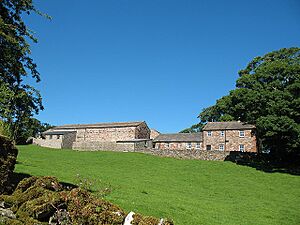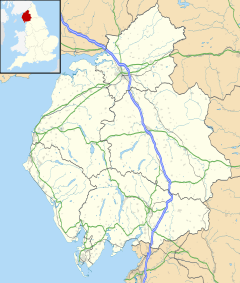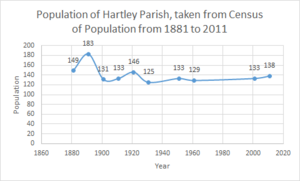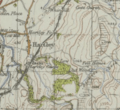Hartley, Cumbria facts for kids
Quick facts for kids Hartley |
|
|---|---|
 Hartley Castle |
|
| Population | 138 (2011) |
| OS grid reference | NY7808 |
| Civil parish |
|
| District | |
| Shire county | |
| Region | |
| Country | England |
| Sovereign state | United Kingdom |
| Post town | KIRKBY STEPHEN |
| Postcode district | CA17 |
| Dialling code | 01298 |
| Police | Cumbria |
| Fire | Cumbria |
| Ambulance | North West |
| EU Parliament | North West England |
| UK Parliament |
|
Hartley is a small village in the Eden area of Cumbria, England. It's about half a mile (0.8 km) east of Kirkby Stephen. This area used to have many lead and copper mines, but they are now closed. You can also find lots of iron ore here.
One interesting feature in Hartley is the "Nine Standards." These are nine tall stone pillars found at the highest point in the village. No one is completely sure why they were built. Some people think they were used to make enemies believe a large army was coming. Others believe they were markers to show the border between the old counties of Westmorland and Yorkshire. Hartley is also home to Hartley Castle. It was first built around 1353 as a strong tower house. It was made bigger around 1600 and then changed again in the 1700s. The castle stands at the southern end of Hartley.
Contents
A Quick Look at Hartley's History
The history of Hartley is linked to who was in charge of England at different times. In the 1200s, a knight named Sir Andrew de Harcala lived at Hartley Castle. He worked for King Edward II and later became the Earl of Carlisle.
However, when Robert the Bruce invaded northern England, Sir Andrew de Harcala was accused of treason (betraying his country). He was then executed. After this, the new owner of Hartley Castle made the house even stronger. Sir Andrew also owned other lands, including the Kings Watermill, now called Hartley Low Mill. When he was executed, he lost the mill too.
The Kings Watermill was later sold to the Musgraves family. Sir Philip Musgrave repaired the mill in 1754. In 1914, the Musgraves family sold Hartley Low Mill to James Cleasby. Since then, many different people have owned and lived at the mill throughout the 1900s.
How Hartley's Population Changed
The number of people living in Hartley has stayed quite steady over many years. Hartley is a very small place, so big changes in population are rare. In 1891, 183 people lived there. This was the biggest change in population over a ten-year period, with 54 more residents.
Throughout the 1900s and into the early 2000s, the population numbers remained fairly constant. In 2011, Hartley had 138 residents. To put this in perspective, the entire Eden district had a population of 52,564 in 2011. This means Hartley made up only a tiny part (0.26%) of the Eden district's total population.
Jobs in Hartley in 1881
The census from 1881 tells us about the different jobs people had in Hartley. One big difference was how jobs were split between men and women. Most women in Hartley either had unknown jobs or worked in domestic services. This means they might have been maids or cleaners. Only one woman had a professional job, and she was the only person in Hartley with such a job.
Men in Hartley had more specific jobs. The most common job for men in 1881 was in agriculture, like farming. This shows that farming was a very important part of life in Hartley. Men usually had jobs that involved physical labor. Women, on the other hand, often did not have jobs outside the home.
At this time, society expected men to earn money for their families. Women were often expected to stay home and take care of the children and the house. It was very hard for women to get jobs because of these social views.
Jobs in Hartley in 2011
In 2011, Hartley had a population of 138 people. The 2011 census also shows us the jobs men and women had. A key difference from 1881 is the higher number of women and men with professional jobs. For women, the most common jobs were professional ones (10 women).
For men, the most popular jobs were skilled trades (13 men), followed closely by managers, directors, and senior officials (11 men). The least common jobs for both genders were in sales, customer service, machine operation, and elementary occupations.
A big change from 1881 is the increase in employed women. In 1881, only one woman had a professional job. By 2011, this number had grown to ten. The types of popular jobs also changed. In 1881, many jobs involved manual labor, like farming. In 2011, more people worked in less physically demanding jobs. For example, a larger part of Hartley's population worked as managers or directors in the service sector.
Images for kids





